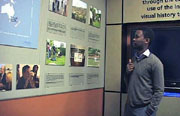VOA标准英语2011--Documentarians Learn Ways to Best Preserve History of Rwanda's Painful Past(在线收听)
Documentarians Learn Ways to Best Preserve History of Rwanda's Painful Past
Four staff members from the Kigali Genocide Memorial Center in Rwanda recently traveled to Los Angeles to learn techniques on how to best preserve the oral history of what happened in Rwanda 17 years ago. As many as one million people lost their lives in the Rwandan Tutsi genocide of 1994. Many people did survive the horror, and their stories are waiting to be heard.
Yves Kamuromsi and three of his colleagues traveled thousands of miles from home to the University of Southern California to learn how to best document and preserve a painful past.
"My elder brother and my parents were both killed,” said Kamuromsi.
Kamuromsi was only 13 when the Rwandan genocide occurred. He said the worst part of the experience is the aftermath.
“First of all you ask the questions like, 'why did that happen?' and 'why [did] that [happen] to you and your family?' but at the same time you ask yourself why you're alone. For example, when you start going to school you find [it] difficult because no parents,” he said.
For Kamuromsi, talking about his experience and sharing it with other survivors helps.
 |
| Yves Kamuromsi - only 13 when the Rwandan genocide occurred - now heads the documentation center at the Kigali Genocide Memorial Center in Rwanda, and said sharing the experience with other survivors helps everyone, November 2011. |
"It’s important because you get to learn the experience of others. At some point you may feel that you're a lucky survivor because you may see that some others have experienced [more] horrible things than you did. So I think sharing stories is a part of the healing process,” said Kamuromsi.
Having survivors speak
Kamuromsi now heads the documentation center at the Kigali Genocide Memorial Center in Rwanda. He has videotaped and interviewed other survivors of the genocide. He said since 2004, his team has collected 200 interviews.
"There are more than 300,000 survivors, but the difficult question is: 'Are they ready to start talking,'” he said.
For many survivors it is still too soon.
“The Rwandan genocide was 17 years ago, but for me it was this morning. It’s still that vivid,” said retired Lieutenant General Romeo Dallaire. He was the force commander of the U.N. peacekeeping force during the Rwandan genocide. He said it is important for survivors tell their stories so the suffering caused by the brutality of their attackers is not lost to the rest of the world.
“The rest of the world also lost its sense of humanity because it let that slaughter happen. We saw it in the media, we heard about it, it was going on for 100 days and we did nothing,” said Dallaire.
Archiving the stories
The Shoah Foundation Institute at the University of Southern California has been collaborating with the Rwandan team collecting the survivor interviews. Established in 1994 by movie director Steven Spielberg after his movie Shindler’s List, the Shoah Foundation Institute collected 52,000 testimonies of the survivors of the Holocaust.
Now, the institute is training Kamuromsi and his colleagues to better conduct interviews, and about how to store, preserve and archive the survivors’ stories. The institute also is collecting video testimonies of the survivors of the mass killings in Cambodia and Armenia.
The executive director of the institute, Stephen Smith, said while each case is different, there are commonalities.
"We absolutely need to be able to compare the causes and the consequences of genocide. If we know what happened and we understand the pattern and the similarities, it gives us that early warning, and nobody knows better than the victims what happens in a situation of genocide, so their voices are a warning for our future,” said Smith.
The stories from Rwanda and other countries will be sent to computer servers in California and then distributed to 34 universities and museums around the world, where the voices of the survivors can be heard.